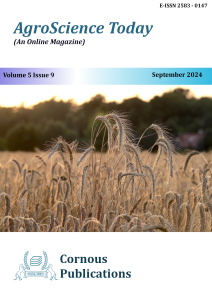Biofortification of wheat is a crucial strategy to combat global micronutrient deficiencies, particularly in regions where wheat is a staple food. By enhancing the nutrient content of wheat through conventional breeding, genetic engineering, and agronomic practices, biofortification can improve public health by reducing deficiencies in essential nutrients like iron and zinc. This sustainable approach offers long-term benefits, including better health outcomes, reduced healthcare costs, and increased resilience to climate change. Despite challenges such as public acceptance and accessibility, biofortified wheat has the potential to contribute to global food security and nutrition significantly.
Climate change accelerated events force scientists to develop alternative strategies to cope up the situation without affecting food security. Foxtail millet is a model C4 plant, their properties such as drought tolerance, improved nutrient content with limited inputs makes this a potential crop for climate resilient studies. The C4 metabolism, growth, physiology and development of foxtail millet under elevated CO2 revealed that the yield can be improved with alterations in photosynthetic machinery. Further, the foxtail millet is drought tolerant; its potential of yield and under different water stress can be more beneficial. Moreover, from the literatures it can be evident that P and N nutrition supplementation enhances the drought tolerant capability of foxtail millet. Researchers across the globe has studied impact of elevated CO2 on the growth physiology and nutrient quality of seeds of this model C4 plant fox tail millet. However, microbial mediated climate smart agriculture is gaining momentum, research has sown AM fungi could tolerate and multiply on elevated CO2 and increase yield of crops.
Mycotoxins, also known as aflatoxins, are low molecular weight secondary metabolites that are mostly produced by Aspergillus species fungi, including A. flavus, A. parasiticus, and a few others, including A. pseudotamarii, A. bombycis, A. nomius, and A. ochraceoroseus. Numerous crops like groundnuts, cereals, fruits and vegetable and other processed products are prone to aflatoxin contamination, produced by fungi belonging to the Aspergillus section Flavi fungi. The presence of aflatoxins in crops leads to both health and economic challenges in numerous areas. Many countries have established specific thresholds (ranging from 2 to 20 ppb) for permitted levels of aflatoxin contamination in their food and agricultural products intended for human or animal consumption. A number of techniques have been used to get rid of aflatoxins from contaminated food and feed.
Krishi Vigyan Kendra is the centre for transfer of season specific technologies to farmers, farm women, rural youth. Recent days KVK has given main focus on organic farming. Various trainings programmes, method demonstration on organic input production, front line demonstrations, frequent field visits and regular advisory services conducted. Farmer Th.S. Kulandaivel KVK trained farmers and having believed on organic farming. Started doing organic practice on since last three years. He is the president of Semmankadu KVK Farmers' Group and doing service to his group members. He earns profit of R.3000/day from Roses and Chillies sales at daily market.
